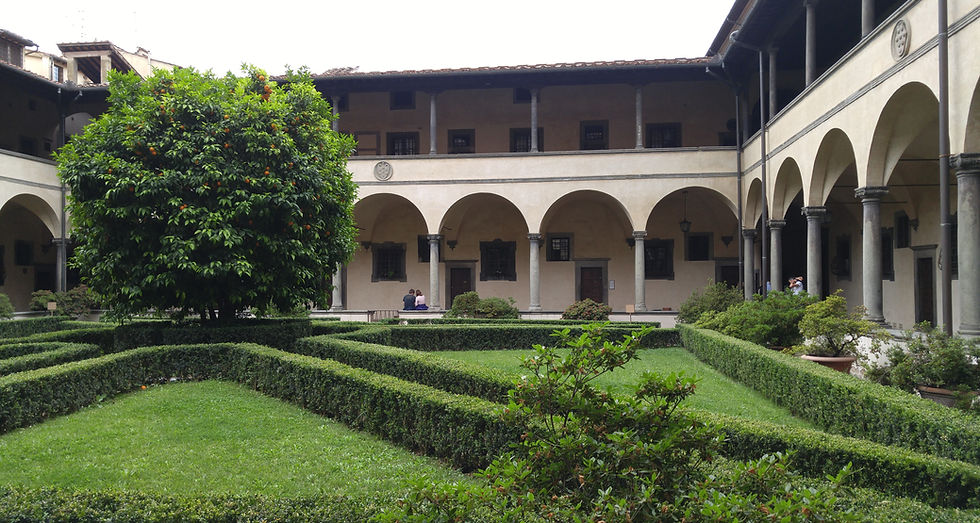Finding shadows in unexpected places!
- Jill Price
- Jun 6, 2016
- 4 min read


Once again, June 6th in Florence provided us with great food, architecture and plenty of information. We began our morning by back tracking to the library designed by Michelangelo that is attached to the San Lorenzo Basilica. Passing by a charming orange tree in the middle of a highly manicured courtyard, one enters into a dark and revered lobby occupied by a three part staircase intended to lift you to enlightenment. As you look up at the walls you notice that all the square niches are left empty, not only as a nod to Brunelleschi, my new hero of design, but also to invite each user of the bibliotheca to fill their own empty page with knowledge. It would seem that I am loving this challenge.

Once inside, the desks are wonderfully upright, which seemed very smart to me in that one would not be able to put their head down and fall asleep. Lightly coloured stained glass window align with each row of desks on either side of the hall so that there is ample lighting from dusk to dawn. What was really neat was that each desk was affixed with books of different learning. A reader would need to move from desk to desk to read up on different subjects, with the books chained to the sturdy wood shelves beneath the tilted work surfaces. Past the study hall was what I thought was going to be a boring exhibition of important bound illuminated manuscripts adorned with columns of beautiful hand written script and impressive illustration. Surprised, what I discovered were more interpretations of the shadow and how it relates to text, the page, or the book. I began by trying to document the shadow beneath the open covers of the book, but the Plexiglas

covers hindered capturing the dark space atop of red velvet. Then I began to recognize within the pages themselves. Stains, fading, wrinkles and writing within the margins worked to obliterate what and how we saw the original text. Examining the exquisite shapes of the Latin calligraphy, I then began to see each dark letter as a shadow of the negative space around it. Additionally, I started to reflect on how writing is architecture and that each work or letter that comes before the next serves to cast a shadow of knowledge or provides context of understanding onto the reading of the next. This notion could also ring true with the approach of the reader, for every new reader becomes a new interpreter or translator for the text and hence a new author through the reading of the work. Hmm…this sounds familiar. (Death of an Author by Roland Barthes)
We also visited the Orsanmichele which the city’s grainery constructed on the site of the kitchen garden of the monastery of San Michele in 1337. It began its conversion to a church in 1380. Over the years “guilds were charged by the city to commission statues of their patron saints to embellish the facades of the church.” Now replicas, they surround the church carefully perched within their perspective niches. You can still recognize many of these guilds still present in the streets of Florence today through the selling of textiles, baked goods, roses, stone work, leather goods (Way too many dead cows in the form of leather here!), shoemakers ( more leather) and butchers (more cows). The inside is hauntingly beautiful and as Geoff said, “impressive and oppressive simultaneously”. This duplicity of nature lurks in the shadows of each one of us and for those of you who told me to read Jung, thank you.

Upon entering the upper levels of the church, now the museo for the original sculptures I started to think about the word niche and how they physically cast shadows or hide aspects of that which they contain. I also thought about niche in relation to focused realms of study and how perhaps those who reside within these niches continue to exist within Plato’s Cave of knowledge in that they are isolated from other forms of culture and their audiences. I spoke this to my professor and she suggested that there is comfort to be found in the niches as we can’t ever begin to know or understand everything.
So this brings me to copies or adaptations. It would seem that both are shadows of an original work and depending on the audience, medium, cost or context, they may reach further or wider than their predecessor. So how did I arrive at this? The majority of sculptures you see in Florence in public spheres are copies of originals which now lie inside museums. Each of the copies would have been cast from the originals just as shadows are cast from original forms. The only difference is the medium used in this creative process. So this begs to be asked, am I simply copying if my work is to be derived from shadows?
I will let you fill the rest of the page with your answer.















